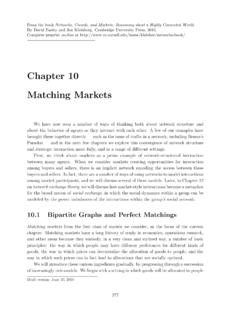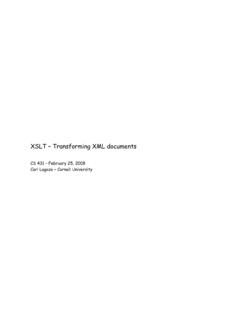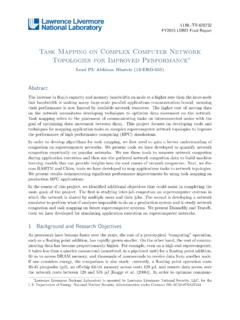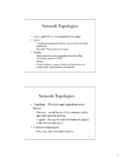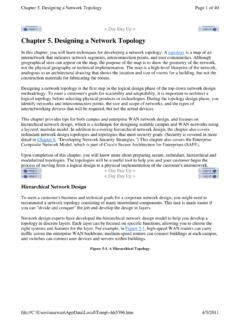Transcription of Data Center Network Topologies II - Cornell University
1 data Center Network Topologies IIHakim WeatherspoonAssociate Professor, Deptof Computer ScienceCS 5413: High Performance Systems and NetworkingApril 10, 2017 March 31, 2017 Agenda for semester Project Continue to make progress. BOOM proposal due TODAY, Mar 31. Spring break next week! Week of April 2nd Intermediate project report 2 due Wednesday, April 12th. BOOM, Wednesday, April 19 End of Semester presentations/demo, Wednesday, May 10 Check website for updated schedule Overview and Basics Overview Basic Switch and Queuing (today) Low-latency and congestion avoidance (DCTCP) data Center Networks data Center Network Topologies Software defined networking Software control plane (SDN) Programmable data plane (hardware [P4] and software [Netmap])
2 Rack-scale computers and networks Disaggregated datacenters Alternative Switching Technologies data Center Transport Virtualizing Networks Middleboxes Advanced topicsWhere are we in the semester? Interested Topics: SDN and programmable data planes Disaggregated datacenters and rack-scale computers Alternative switch technologies Datacenter Topologies Datacenter transports Advanced topics4 Where are we in the semester?Architecture of data Center Networks (DCN)Conventional DCN Problems Static Network assignment Fragmentation of resource Poor server to server connectivity Traffics affects each other Poor reliability and.
3 Want moreI have spare ones, :51:801:240 Objectives: Uniform high capacity: Maximum rate of server to server traffic flow should be limited only by capacity on Network cards Assigning servers to service should be independent of Network topology Performance isolation: Traffic of one service should not be affected by traffic of other services Layer-2 semantics: Easily assign any server to any service Configure server with whatever IP address the service expects VM keeps the same IP address even after migrationDiscuss Today81.
4 L2 semantics2. Uniform high capacity3. Performance ..CRCRARARARARSSSSSSSSSSSS..Virtual Layer 2 Switch (VL2)Approach A Scalable, Commodity data Center Network Architecture M. Al-Fares, A. Loukissas, A. Vahdat. ACM SIGCOMM Computer Communication Review (CCR), Volume 38, Issue 4 (October 2008), pages 63-74. Main Goal: address the limits of data Center Network arch single point of failure oversubscription of links higher up in the topology trade-offs between cost and providing Key Design Considerations/Goals Allows host communication at line speed no matter where they are located!
5 Backwards compatible with existing infrastructure no changes in application & support of layer 2 (Ethernet) Cost effective cheap infrastructure and low power consumption & heat emissionInternetServersLayer-2 switchAccessData CenterLayer-2/3 switchAggregationLayer-3 routerCoreApproach BackgroundApproach Background Oversubscription: Ratio of the worst-case achievable aggregate bandwidth among the end hosts to the total bisection bandwidth of a particular communication topology Lower the total cost of the design Typical designs: factor of 2:5:1 (4 Gbps) to 8:1( Gbps) Cost: Edge: $7,000 for each 48-port 10 GigE switch Aggregation and core: $700,000 for 64-port 100 GigE switches Cabling costs are not considered!
6 Properties of the solution Backwards compatible with existing infrastructure No changes in application Support of layer 2 (Ethernet) Cost effective Low power consumption & heat emission Cheap infrastructure Allows host communication at line speedClosNetworks/Fat-Trees Adopt a special instance of a Clos topology Similar trends in telephone switches led to designing a topology with high bandwidth by interconnecting smaller commodity switches. Inter-connect racks (of servers) using a fat-tree topologyK- aryfat tree: three-layer topology (edge, aggregation and core) each pod consists of (k/2)2servers & 2 layers of k/2 k-port switches each edge switch connects to k/2 servers & k/2 aggr.
7 Switches each aggr. switch connects to k/2 edge & k/2 core switches (k/2)2core switches: each connects to k podsFat-tree with K=4 FatTree-based DC Architecture Why Fat-Tree? Fat tree has identical bandwidth at any bisections Each layer has the same aggregated bandwidth Can be built using cheap devices with uniform capacity Each port supports same speed as end host All devices can transmit at line speed if packets are distributed uniform along available paths Great scalability: k-port switch supports k3/4 serversFat tree Network with K = 6 supporting 54 hostsFatTree-based DC ArchitectureClos Network Topology17.
8 TOR20 ServersInt..AggrKaggr switches with Dports20*(DK/4) Servers..Offer huge aggrcapacity & multi paths at modest costD (# of 10G ports)Max DC size(# of Servers)4811,5209646,080144103,680 Does using fat-tree topology to inter-connect racks of servers in itself sufficient? What routing protocols should we run on these switches? Layer 2 switch algorithm: data plane flooding! Layer 3 IP routing: shortest path IP routing will typically use only one path despite the path diversity in the topology if using equal-cost multi-path routing at each switch independently and blindly, packet re-ordering may occur; further load may not necessarily be well-balanced Aside: control plane flooding!
9 18 FatTreeTopology is great, with Fat-tree Layer 3 will only use one of the existing equal cost paths Bottlenecks up and down the fat-tree Simple extension to IP forwarding Packet re-ordering occurs if layer 3 blindly takes advantage of path diversity ; further load may not necessarily be well-balanced Wiring complexity in large networks Packing and placement technique Enforce a special (IP) addressing scheme in DC Allows host attached to same switch to route only through switch Allows inter-pod traffic to stay within podFatTreeModifiedDiffusion Optimizations (routing options)1.
10 Flow classification, Denote a flow as a sequence of packets; pod switches forward subsequent packets of the same flow to same outgoing port. And periodically reassign a minimal number of output ports Eliminates local congestion Assign traffic to ports on a per-flow basis instead of a per-host basis, Ensure fair distribution on flowsFatTreeModified2. Flow scheduling, Pay attention to routing large flows, edge switches detect any outgoing flow whose size grows above a predefined threshold, and then send notification to a central scheduler.

